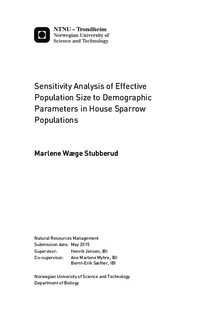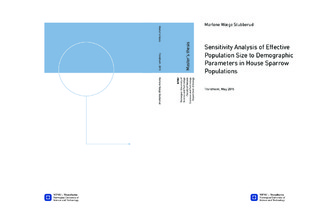| dc.description.abstract | In population management, the effective population size, Ne, can be viewed in tandem with actual population size, N, as the main factors determining a population s long-term viability and sustainability. Ne is the number of individuals in an observed population that would lose genetic variation at the same rate as an ideal population. Understanding which demographic factors that affect Ne/N, will make resource allocation and decision making more effective, either if the management goal is to maximise, maintain or minimize Ne/N. The goal of this thesis was to calculate the demographic parameters that determine Ne/N, following the method of Engen et al. (2010), and then determine which of these parameters Ne/N is most sensitive to. In other words, determine which parameters that contribute most to the total variation in Ne/N. This was done, using data on 13 Norwegian populations of house sparrows (Passer domesticus), including more than 4000 individuals, and spanning up to 20 years. To find which of the demographic parameters (demographic variance, generation time, stable age distribution, reproductive values, individual fecundity and survival) that affect Ne/N most, sensitivity analyses were carried out. Using the global variance-based Sobol method, it was found that demographic variance, especially of older individuals, was the parameter that Ne/N was most sensitive to. Generation time was found to be less important than demographic variance, which includes all the other parameters. The demographic variance of a population is determined by fecundity and survival on the individual level. The individual reproductive values were found to be most sensitive to fecundity, followed by survival. In contrast, the stable sex-age distributions, and the sex-age specific reproductive values, were found to be of little importance. For population management purposes, the results from this study shows that resources should be focused on the manipulation of demographic variance in older individuals, more specifically their fecundity and survival. Even though these results are from insular populations of house sparrows, they may also to fragmented populations of other species with similar life histories and demography. | |

